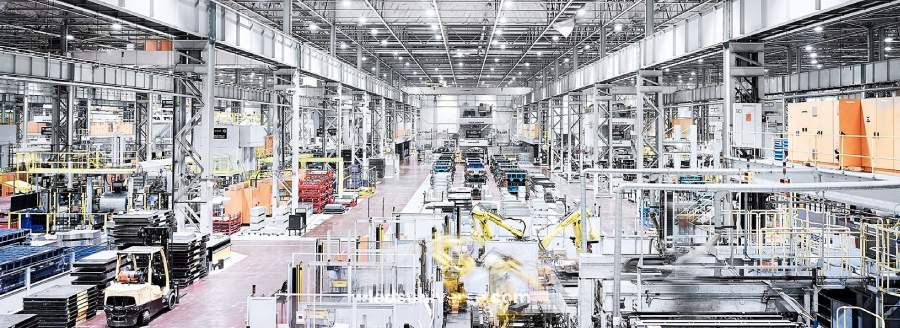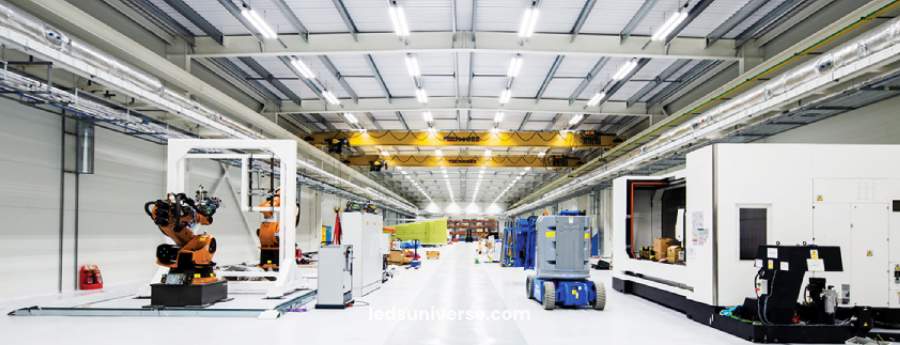Factory lighting has come a long way from the dim, flickering fluorescents of the past. Today, it’s at the forefront of a transformative era where cutting-edge technology meets operational efficiency. With advancements that extend beyond mere illumination, the latest factory lighting solutions offer enhanced durability, energy efficiency, and smart features that adapt to the dynamic needs of industrial environments.
Over the years, factories have transformed from dim, hazardous work environments into modern, well-lit production hubs. Today’s factory lighting solutions not only improve worker morale and productivity but also contribute to energy savings and reduced operational costs.
Reach out for free lighting consultation
Table of Contents
ToggleIn any factory environment, achieving uniform lighting is crucial to ensure that every area of the workspace is consistently illuminated. Uniform lighting minimizes the presence of shadows and dark spots, which can be a significant safety hazard and contribute to visual strain among workers. A well-lit environment not only enhances overall visibility but also plays a vital role in reducing the likelihood of accidents and errors that can occur due to poorly illuminated areas.
Uniformity in lighting helps in creating a more predictable visual environment, where workers can perform tasks with greater accuracy and less discomfort. Variations in light intensity can lead to fatigue and reduced productivity, as workers may struggle to see clearly or experience discomfort from glaring lights or sudden contrasts. Therefore, maintaining consistent illumination across the entire workspace is essential for optimizing worker performance and ensuring a safe working environment.
Lux levels, which measure the intensity of light falling on a surface, are a key factor in determining the effectiveness of factory lighting. The required lux level varies significantly depending on the nature of the tasks being performed. For intricate tasks that demand high precision, such as assembly or quality control, higher lux levels are necessary to provide the clarity and detail needed for accurate work. Conversely, for general warehouse operations or less detail-oriented tasks, lower lux levels may be sufficient.

Understanding the specific lighting needs of different areas within a factory is crucial for selecting appropriate lighting solutions. For example, production lines and inspection areas typically require higher illumination levels compared to storage or shipping areas. Tailoring the lux levels to the requirements of each specific area ensures that all tasks are performed under optimal lighting conditions, thus enhancing productivity and reducing errors.
Color temperature, measured in Kelvin (K), is another critical aspect of factory lighting that affects both visibility and worker comfort. The color temperature of lighting impacts how colors are perceived and how well details are discerned, which is especially important in industrial settings where accuracy and clarity are paramount.
Factories generally benefit from lighting that mimics natural daylight, with a color temperature range between 4000K and 6500K. This range provides a clear, white light that enhances visibility and reduces the risk of errors. Daylight-like illumination helps in maintaining color accuracy and contrast, which is vital for tasks such as quality inspection, detailed assembly work, and precision machining.
In addition to improving visibility, the right color temperature can influence the mood and alertness of workers. Lighting that is too warm or too cool can affect workers’ comfort levels and potentially impact their productivity. A color temperature that closely resembles natural daylight helps in creating a more pleasant and stimulating work environment, which can contribute to higher levels of focus and efficiency.
Moreover, the proper color temperature can reduce visual fatigue and strain, making it easier for workers to maintain their concentration over extended periods. By choosing lighting with an appropriate color temperature, factories can not only enhance the accuracy of work but also support the overall well-being of their employees.

Factory lighting fixtures must withstand harsh conditions, including dust, moisture, and physical impact. High-quality, robust fixtures are designed to be shockproof, dustproof, and resistant to extreme temperatures. This durability is essential for maintaining consistent performance in challenging environments. For instance, LED high bay lights are particularly suitable for factories due to their sturdy construction and ability to operate effectively in high-ceiling spaces.
Maintenance is a critical factor in factory lighting. LED lights, with their long lifespan of up to 80,000 hours, significantly reduce the need for frequent replacements and repairs. This longevity not only lowers maintenance costs but also minimizes downtime, ensuring that factory operations remain uninterrupted. Additionally, LEDs have no warm-up period and can be instantly turned on or off, making them ideal for factories with frequent power fluctuations or varying lighting needs.
Designing an effective lighting layout involves assessing the factory’s spatial dimensions and the specific tasks performed in each area. A well-planned layout ensures that all work areas receive adequate illumination, enhancing both safety and productivity. The layout should include a mix of general, task, and accent lighting to address different needs. For instance, high bay lights are ideal for general illumination in large spaces, while task lights can focus on specific workstations requiring precise lighting.
Proper installation is crucial for maximizing the performance of factory lighting systems. It involves positioning lights to minimize glare, avoid shadows, and ensure even coverage. Installation should also consider the ease of access for future maintenance and repairs. Working with experienced professionals can help ensure that the lighting system is installed correctly and adheres to safety standards.
LED lighting offers significant advantages over traditional lighting options, including lower energy consumption and reduced heat output. Unlike conventional metal halide lights, LEDs produce minimal heat, which can ease the burden on air conditioning systems and further reduce energy costs. The efficiency of LED lights also translates into lower electricity bills and less frequent replacements, contributing to long-term cost savings.
The transition to LED lighting not only improves energy efficiency but also enhances the overall working environment. Factories that adopt LED lighting report a reduction in complaints related to heat and glare, creating a more comfortable and productive workspace. Additionally, the reduced heat output from LEDs helps to alleviate the strain on HVAC systems, resulting in lower maintenance costs and improved air quality.
Recent advancements in LED technology have significantly transformed factory lighting, providing enhanced efficiency, durability, and flexibility. One of the most notable innovations is the development of advanced heat sink technology. Heat sinks are critical components designed to dissipate heat generated by LED fixtures. By effectively managing and reducing internal temperatures, heat sinks prevent overheating, which can otherwise shorten the lifespan of LEDs and compromise their performance. This innovation not only extends the operational life of LED fixtures but also maintains consistent light output and reduces the need for frequent replacements.
The advancement in heat sink technology has led to more robust and reliable LED lighting solutions. Factories can now benefit from LED fixtures that are capable of withstanding harsh environmental conditions, including high temperatures, dust, and moisture. These improvements make LED lights ideal for the demanding conditions often found in industrial settings. With increased durability, factories experience fewer interruptions due to lighting failures, resulting in more stable and efficient operations.
Another significant advancement in factory lighting is the integration of smart lighting solutions. These systems incorporate occupancy sensors, automated controls, and advanced dimming capabilities to optimize lighting based on real-time needs. Occupancy sensors detect the presence of workers and adjust the lighting accordingly, ensuring that lights are only on when needed. This not only contributes to significant energy savings but also enhances the overall efficiency of factory operations.
Smart lighting controls can be programmed to adapt to varying levels of activity throughout the factory, further reducing energy consumption. For example, in areas with minimal activity or during non-working hours, the lighting can be automatically dimmed or turned off, reducing power usage. Additionally, advanced dimming features allow for precise adjustments to light intensity based on specific tasks or preferences, contributing to better working conditions and energy efficiency.
The integration of LED lighting with the Internet of Things (IoT) and data analytics represents a cutting-edge advancement in factory lighting. IoT-enabled lighting systems can be monitored and controlled remotely, providing real-time data on lighting performance, energy consumption, and maintenance needs. This capability allows factory managers to make informed decisions about lighting adjustments and maintenance, further optimizing energy use and reducing operational costs.
Factory lighting has evolved significantly, thanks to advancements in LED technology and a greater understanding of lighting requirements. By focusing on uniformity, appropriate lux levels, and color temperature, factories can improve visibility and worker comfort. Durable fixtures, easy maintenance, and effective design and installation further contribute to optimal lighting solutions. As lighting technology continues to advance, factories can expect even greater improvements in efficiency, safety, and cost savings. Investing in modern lighting solutions not only enhances the operational aspects of a factory but also supports a healthier and more productive work environment.